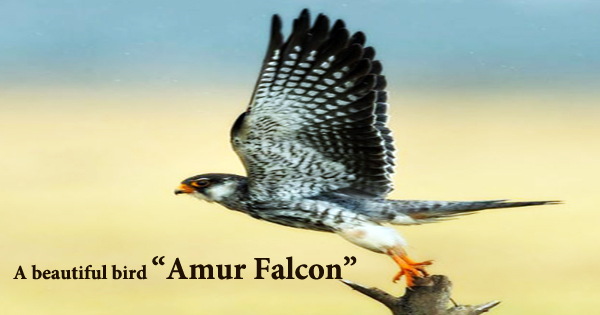The Amur falcon takes to the air in fall in far eastern Asia, embarking on a 22-thousand-kilometer journey that will take it over the Himalayas, across the Indian Ocean, and into all of East Africa. The Amur falcon (Falco amurensis) belongs to the falcon family and is a tiny raptor. It breeds in southern Siberia and northern China before traveling in vast flocks across India and over the Arabian Sea to spend the winter in southern and eastern Africa. It’s an incredible migratory raptor. Stopover places are critical for Amur Falcons to preserve endurance throughout their lengthy flight. While traveling through a rural section of India’s Nagaland region in 2012, an estimated 120,000 to 140,000 birds were caught in nets and slaughtered. The Indian government and the Nagaland Forest Department reacted quickly, using patrols and teaching programs for locals to put an end to the traps. There were no falcons captured in 2013. With a wingspan of 63–71 cm and a weight of around 120 g, the Amur falcon is a medium-sized falcon. The masculine and female are diametrically opposed. The male has dark sooty grey thighs and a brownish-red vent. When flying, the male’s wings have a white line that contrasts with the sooty grey. The female has a black speckled chest and vent on a white background, as well as a darker, grey back, which is characteristic in many falcon species. The orange of the eye-ring, beak base (the cere), and foot distinguishes both the male and female. The male, like many other birds of prey, is smaller than the female, weighing around 97-155 g compared to 110-188 g for the female. Females are more difficult to see since they have a pattern that is shared by many falcons, but they have an orange eye-ring, a red cere, and reddish-orange feet that set them apart. Juveniles are only similar to red-footed falcons in appearance but lack the buffy underwing coverts. The issue of unlawful capturing and killing during migration is shown by the Amur Falcon, which threatens numerous bird species each year. Aside from that, agricultural activities and land reclamation threaten the birds’ habitat.

As these species become more endangered, only worldwide collaboration from groups and governments working together will help them survive. The Amur falcon is one of just a few sociable birds of prey. Even though many raptor species can be seen flocking together on occasion, such as during migration or near a food source, Amur falcons appear to breed, migrate, and roost together. Most reports of its migration say that as it flies down from the sky to roost for the night, it does so in enormous flocks, ranging from 5 to 250 birds. The Transbaikalia, Amurland, and northern Mongolian regions, as well as sections of North Korea, are all breeding grounds for the Amur falcon. They travel across a broad front through India and Sri Lanka, occasionally further east via Thailand and Cambodia, and then across the Arabian Sea, passing through the Maldives and other islands on their way to southern Africa. Each year, tens of thousands of birds undertake the 15,000-kilometer journey. Even more amazing is the fact that the 3,000-kilometer journey from Africa’s horn to Asia is completed in a single flight. It’s thought that they employ the wind and currents to help them fly. The Amur falcon mostly feeds late at night or early in the morning, catching a variety of insects in the air or on the ground. They catch most of their prey in flight, occasionally hovering, but they will also alight on the ground to catch animals. Although their winter diet appears to be nearly completely insect-based, they feed their young in their breeding region with tiny birds, mammals, and amphibians. They live in open woods and wetlands in Asia. They live in open woodlands and savannah grasslands in Africa, frequently roosting on large trees. They have also been observed roosting in tiny settlements near open areas. Several pairs of birds may nest near together during breeding, which takes place in late May or early June. Abandoned nests of other birds of prey or corvids are frequently re-used. A total of three or four eggs are deposited (at two day intervals). Both parents take turns incubating and feeding the chicks, which hatch after about a month in the nest and fly out after about a month. Illegal hunting has been one of the greatest dangers to Amur falcons throughout their journey. Toxic pesticides have an influence on them as well. Falcons, ironically, are crucial agricultural pest predators. As a result, falcon population reductions may have a detrimental impact on agricultural production.
















